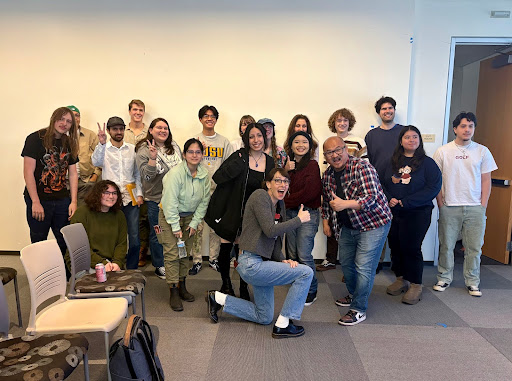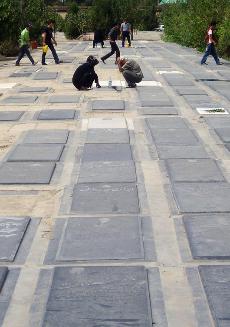Kayhan Yekgrangi, 21, traveled with his father in Iran for a month earlier this semester. It was Yekrangi’s first trip to Iran and his father’s first since coming to the United States in 1984 after the Iranian revolution. Yekgrangi’s mother is from Louisiana, so he did not grow up immersed in Iranian culture. The family celebrated a few Iranian holidays, but English was always spoken at the dinner table, except when relatives visited. Yekrangi has since become fluent in Persian after taking language classes at DVC and working with a private tutor. His journey blew away the media stereotype of Iranians screaming, “Death to America,” and gave him insight into a country where two-thirds of its 70 million people are under 30 years old.
It began when I stepped from the plane in Tehran and continued later in Esfahan, Shiraz and in northern towns along the Caspian Sea. Everywhere I went, people approached with curiosity and interest.
Where was I from?
Lebanon?
Perhaps Egypt?
Just blocks away from the Parliament building in Tehran, real estate offices literally emptied as workers came outside to get a closer look. Some spoke English, others didn’t, but I could answer because I speak Persian.
Side conversations swirled around me, usually among young girls, often in pairs. One would steal a glance, make brief eye contact and whisper to her friend. The friend would look at me, make eye contact and whisper back.
“He’s American, No?”
“Maybe he’s from the south.
“No way, look at his clothes”
“He’s so handsome.”
****
Iran is a nation in which two-thirds of the population is under the age of 30.
The women streak their naturally dark hair, blonde, their bangs breaking free from under bright scarves, which almost always match the color of their slip-on shoes. Cuffed pants reveal full ankles.
Sunglasses and jeans – Western-brand knock-offs – are the pride of the fashion scene for both men and women. The young men use ounces of gel on their longish hair and wear T-shirts tight enough to be Spandex.
****
Illegal satellite dishes shape Iranians’ view of the West. For them, America is exiled Iranian singers who perform at Los Angeles night clubs and own cars the price of houses. It’s paparazzi photographs of Hollywood celebrities, big-city high rises and massive bridges.
Meanwhile, Westerners view Iran as a country of protests, flag burnings, and surly, turbaned clerics.
I raised these divergent views with a young woman who has just been accepted to Tehran University for nutrition sciences.
“If we rely on media, we’ll never see the real side of the United States or Iran,” she told me.
****
In the span of only 65 years, Iran witnessed a change in royal dynasty, played a dust-settling role in World War II, experienced a CIA coup, a revolution and a bitter eight-year war with neighboring Iraq.
The ruling clerics are determined that these events remain fixed in the consciousness of modern Iranians.
On almost any corner in Tehran, painted murals of Iran’s history grace the walls of public buildings and billboards.
They depict the faces of brigade leaders, generals, clerics, and devoted martyrs who died in battle and during the revolution.
Even in Iran’s most notorious cemetery, Behesht e Zahra, these brave souls are remembered and granted their own section, “The Devotee’s Segment.”
****
Behesht e Zahra, “Zahra’s Heaven,” sits just outside of southern Tehran. In a city of 14 million people, about 1,500 are buried here daily.
Every minute, another casket leaves the prayer room with its party, the men dressed in black and carrying the casket, the women in full black chador.
A person stands at the front of every procession, holding a sign with the dead person’s name to avoid any confusion over which procession to follow.
“There is literally no more room to expand this place,” a relative told me, as we walked in the oppressive heat of open fields of marble and granite.
****
Whether you live in the glamorous, Western-life-craving northern Tehran or the bazaar-driven, conservative, religious southern Tehran, the electricity goes down at least an hour a day.
A problem since the Iraq war, this lack of electricity is exacerbated by
Iran’s population boom and slow reconstruction. It never comes at a
specific time, but it comes every day.
The West fears Iran’s nuclear program is for the development of
weapons, while Iranian leaders claim it’s for generating electricity.
The latest round of U.N. sanctions banned Iran’s state-owned banks
from engaging in international commerce, dealing a major blow to
Iran’s already struggling economy.
Many Iranians blame the blackouts on the sanctions.
“Because of the sanctions, they’re trying to make money by selling
electricity to neighboring countries like Georgia and all those old
communist countries,” said a man in the northern town of Namak
Abrud.
Survival of a modern Shiite Islamic Theocracy is tough in a country
where two-thirds of the population is of the “Internet” generation and
job opportunities are few. Many Iranians give up on their homeland
and start over in the West.
Women make up 65 percent of university students, but discrimination still exists in the few available jobs.
A young clothing store manager, in Tehran offered his view on
whether his generation might bring about change.
“Our generation is a result of our parent’s revolution,” he told me, “
and we’re fearful that, if we start another movement, there could be something worse”.





































































